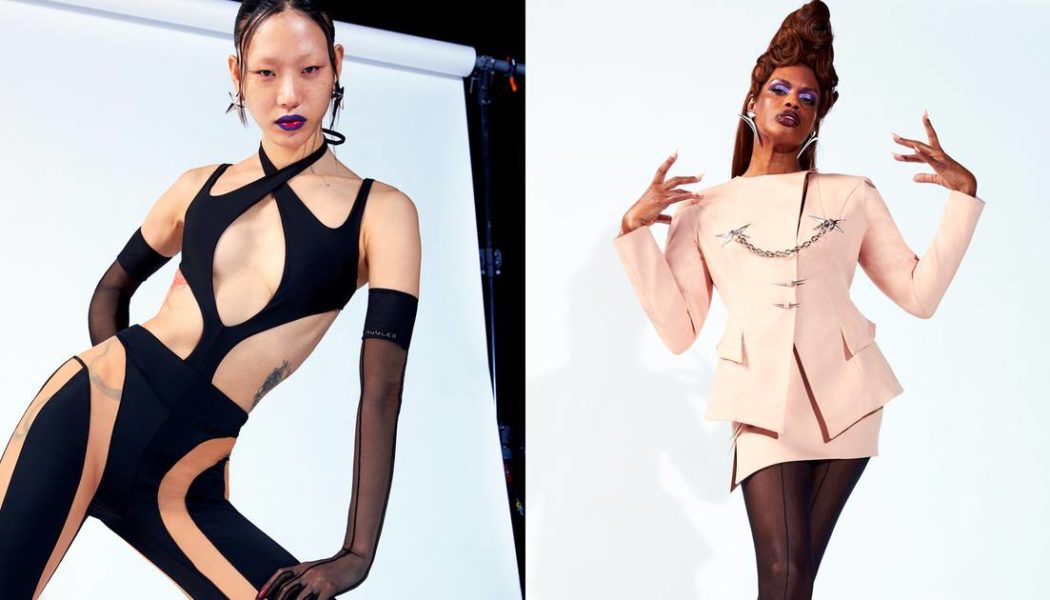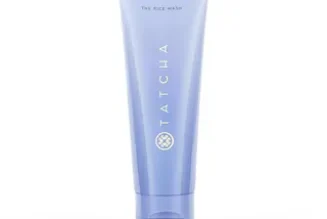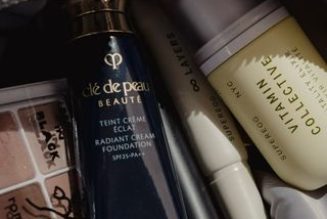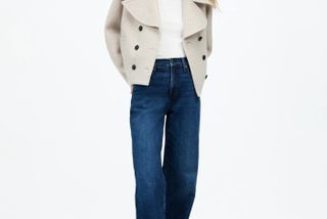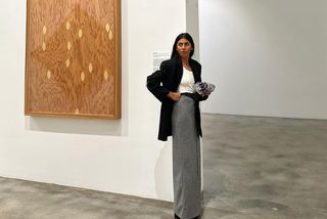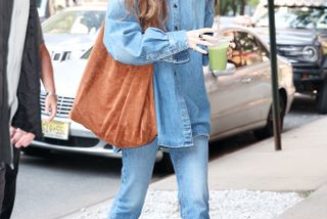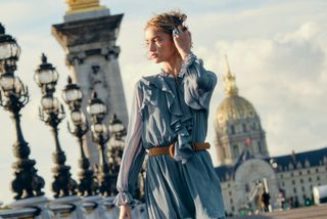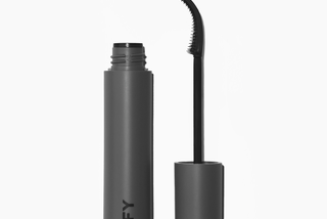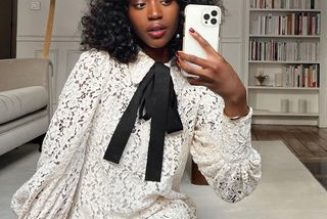
At a recent press event for Mugler’s new collaboration with H&M, its creative director, Casey Cadwallader, made an unusual boast.
“We used a lot of the same materials [for the H&M collaboration] and we made them just as well as our own,” said the American-born designer, noting that the paneled denim and sheer corsetry from Mugler’s premium line transitioned seamlessly — albeit with fewer seams — from his Paris atelier to a global chain store.
The biggest difference is price: the H&M pieces, which go on sale Thursday, range from $49.99 to $749, while pieces from Mugler proper start at $470 and top out at $2800 on Net-a-Porter. A copy of the label’s original velvet “Vampire Dress” from 1981, recently seen on pop star Dua Lipa and Euphoria breakout Sydney Sweeney, will sell for $449 at H&M; the real thing is listed for $18,000 on 1stdibs.com.
Welcome to the new age of high-low collaborations, where TikTok’s “dupe culture” comes to life with willing overlap from the luxury houses themselves. Designers once approached partnerships with fast fashion retailers gingerly. They gave wannabe couture fiends an elusive injection of their brand DNA in exchange for a cash boost and a global advertising platform, and hoped the sight of their hallowed names on dirt cheap dresses wouldn’t come back to haunt them.
Today, luxury labels are just as likely to brag about cloning their greatest hits outright.
“I remember we were shooting the H&M collection,” Cadwallader said, “And my design team was like, ‘Okay, wait, that looks exactly like what we do.’”
What changed?
It’s partly that the stigma around dupes is fading, and it’s always been true that the exposure of a fast-fashion partnership is too good to pass up. But also, in exchange for making mirror images of their most coveted pieces, creative directors get to greenlight items, and often entire categories, that their current label doesn’t produce.
“Eyewear, specifically, was something that I had been thinking about before I did my collaborations,” said Victor Glemaud, who worked with Paco Rabanne and Tommy Hilfiger before launching his own knitwear in 2006. “So we made some for [Target in 2020] and they performed really, really well.”
Today, Glemaud’s optical and sunglasses are licensed through Tura, and make up a notable slice of his revenue.
“I would hope that’s one of the reasons I have an eyewear deal now,” Glemaud says. “Because we had proof of concept thanks to that collaboration.”
How have these collaborations evolved?
H&M was a pioneer of high-low partnerships back in 2004, when Karl Lagerfeld paired with the chain store on a series of pared-down suiting and little black dresses. “It’s all about taste,” Mr. Lagerfeld said in the commercial, which spoofed the horrified French elite throwing their old clothes into the Seine. (The project was so influential that an outfit from it is included in the current Karl Lagerfeld retrospective at the Costume Institute.)
After creating an Isaac Mizrahi partnership in 2003, Target secured a deal with Proenza Schouler in 2007, launching at an Opening Ceremony party. The store’s founders, Humberto Leon and Carol Lim, later had their own Target collab as the creative directors of Kenzo in 2016.
At the time, the rules of a high-low collaboration were simple: Riff on your past pieces to give shoppers a quick thrill (As Zac Posen put it on the release of his Target collection in 2010, “I don’t like the word ‘mass’ … I like ‘fashion-tainment.’” But direct copies were mostly verboten.
Witness Thakoon Panichgul’s Target line in 2008, which featured a $29.99 skirt so close to the buzzy designer’s own $800 version that fashion critic Booth Moore, then at the Los Angeles Times, wrote a piece with the headline, “Thakoon Rips Off Thakoon.” Naturally, that didn’t stop the collaboration from selling out, and being included in Target’s 2019 reissue of designer partnership pieces.
“You could reference your old collection, but the whole game was to translate it for easier manufacturing and a new, presumably younger audience,” said Bonnie Morrison, a strategic marketing and communications advisor who has worked closely with collab-happy brands like Proenza Schouler and Jason Wu in the past. “To make a flat-out copy though? There was a real fear of alienating the customer.”
Today, the rules are more relaxed.
Collaborations with mainstream brands are so ubiquitous — Gucci x XBox or Evian X Balmain, anyone? — that projects are often embraced by a designer’s fans while ignored by the general public.
Dupes are also more convincing. Chain stores like Forever 21 played the game early on, but their quality was often suspect. Even if you convinced people that your $14.99 dress was from Anna Sui, it might literally unravel in the wash. Now, more consumers can afford designer pieces sourced from outlet sites and secondhand markets – not to mention increasingly high-quality, if legally dubious fakes.
To be sure, owning a designer piece — whether from Mugler or any other luxury label — is a sensory and aesthetic experience that can’t fully be replicated at a mass retailer. And fashion is a game of sharp, subtle belonging, which means no matter how “close” a product seems at first glance, true connoisseurs and industry insiders will always call out the dupe.
There’s even a social media trend among editors of spotting duplicate diffusion pieces, marked and priced like the real thing on resale platforms. (A recent example: This Uniqlo x JW Anderson sweater, listed for $155 at The Real Real, with no mention of its provenance. The original retail price: about $50.)
What do designer brands get out of these collaborations?
For some designer brands, fast-fashion chains and big-box stores are almost playing the role of a patron enabling new talent to take their skills and exposure to a higher level.
Cadwallader points to pieces he tried to make for his regular collection that simply couldn’t happen because of lack of consumer interest. (Mugler was acquired by L’Oreal in 2020, but the beauty giant so far does not appear to have lavished the same resources on the business as fashion-focused conglomerates like LVMH or Kering.)
“There’s this long leather trench coat in this beautiful teal colour that was in the [Autumn 2022] runway show,” he said. “I won’t tell you exactly what the Mugler price was, but it was multiple thousands of euros. And it sold under 10 units, and so it had to be cancelled.”
Cadwallader produced the coat for H&M instead (at $749, it’s the most expensive item in the project). He says he’s also used the H&M collaboration to experiment with menswear, which Mugler does not currently produce.
H&M’s sophisticated, global supply chain was also part of the draw, even for a design house like Mugler that has pioneered cut-and-sew techniques for decades.
“I must be honest,” Cadwallader told H&M’s creative advisor Ann-Sofie Johansson during their launch event in New York City. “You did some things with H&M that we can’t do at Mugler. To pave the Lycra in crystals, to get them super close together and the crystals so big, it’s really decadent and really beautiful.”
Cadwallader also mentioned their ability to mass-produce body chains that were once a runway-only phenomenon. An H&M spokesperson said the company used 3D sketching to “get a better understanding of the more complex products in the collaboration.
Is there still a market for more-traditional high-low collaborations?
For luxury veterans like Morrison, collaborating with a worldwide chain store like H&M is still a shortcut to brand visibility and, hopefully, new customer acquisition.
“It gives you a targeted opportunity to expand your network,” she said. “Fashion as a business is so expensive that anyone giving you that shortcut to more eyeballs … and more of a foothold into consumer culture, you’ve got to do it. And true fans of the brand, they’re not going to lose interest because it’s suddenly everywhere.”
Some emerging designers are using their high-low moment to deconstruct their aesthetic entirely.
“Everyone keeps telling me that my runway work is getting weirder and weirder,” says Olivia Cheng, the founder of Dauphinette, which has gained a kind of downtown fame for its chainmail daisy dresses and resin-coated purses made from actual French baguettes. At a recent runway show, her opening look came accessorized with archival Bonnie Cashin blankets and a live baby pig.
Cheng used her current J.Crew capsule to prove “Dauphinette has something for everyone” by transposing her colour-drenched sketches of strawberry gardens and carrot roots onto everyday dresses, swimsuits, and sun hats.
“The collaboration definitely helped me grow my understanding of the [swimwear] category,” said Cheng, noting it also gave her more expertise with the specific needs of the resort and pre-fall customer. “I would gladly collaborate with them again.”
